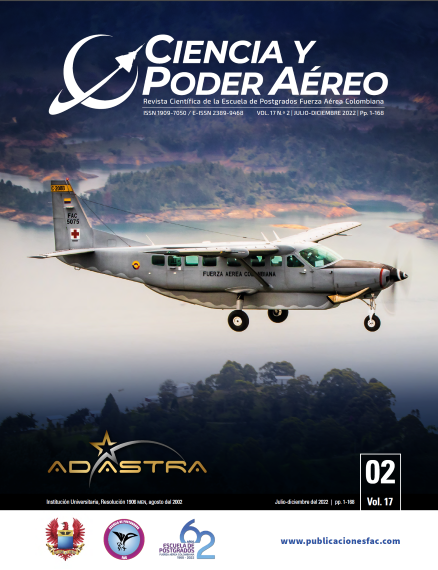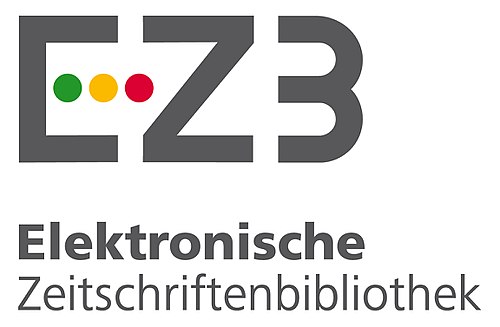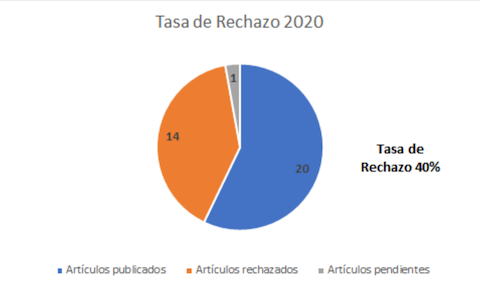Computational evaluation of the cargo compartment of a light aircraft, using free software
DOI:
https://doi.org/10.18667/cienciaypoderaereo.749Keywords:
Structural evaluation, computational fluid dynamics, finite element method, Open-source software, light aircraftAbstract
This paper shows the structural evaluation of a VLA category light aircraf (maximum take-off mass less than or equal to 1200 kg), using computational fluid dynamics (CDF) sofware to evaluate the aerodynamic behavior of the aircraf and the finite element method to evaluate its structural behavior. For its structural evaluation, the aircraf has been divided into cabin, body, and flight surfaces (wings and empennage). The complete models of the aircraf were extracted from the cad model made using SolidWorks® Sofware for each of the sub-components of the cockpit, body and wings, and the empennage. From the calculations and simulations performed, it was concluded that the central structure of the aircraf supports the aerodynamic forces and moments adequately, having values below the yield values of the material. However, it is necessary to reinforce the attachment of the wing to the fuselage to reduce the effort produced in that area. Unlike other methods reported in the literature that use very specialized and high-cost programs, the procedure to evaluate the aerodynamics and central structure of a vla category light aircraf that was developed in this study made use of public domain programs, at around 80 % of the analysis process.
Downloads
References
Aircraft Design: A Conceptual Approach, Sixth Edition. (n.d.). AIAA Education Series. Retrieved March 7, 2022, from https://arc.aiaa.org/doi/abs/10.2514/4.104909
Albadr, A., Hedaya, M., McCrory, J., & Holford, K. (2019). Parametric study of honeycomb composite structure using open source finite element software. https://www.researchgate.net/publication/332383984_Parametric_Study_of_Honeycomb_Composite_Structure_Using_Open_Source_Finite_Element_Software
ASM Material Data Sheet. (n.d.). Retrieved March 3, 2022, from http://asm.matweb.com/search/SpecificMaterial.asp?bassnum=ma6061t6
Bojita, A., Avram, A., Purcar, M., Munteanu, C., & Topa, V. (2017). Thermo-mechanical simulation of the metal-semiconductor structures of power integrated circuits. 2017 International Conference on Modern Power Systems (MPS), 1–6. https://doi.org/10.1109/MPS.2017.7974450
CALCULIX: A Three-Dimensional Structural Finite Elemente Program. (n.d.). Retrieved February 16, 2021, from http://www.calculix.de/
Camara, A. B., Pennec, F., Durif, S., Robert, J.-L., & Bouchaïr, A. (2018). Fatigue life assessment of bolted connections. MATEC Web of Conferences, 165, 10009. https://doi.org/10.1051/matecconf/201816510009
Deák, P. (2018). Vertical tail FEA with a CAD/CAE based multidisciplinary process. Aircraft Engineering and Aerospace Technology, 90(4), 652–658. https://doi.org/10.1108/AEAT-11-2016-0212
Elmer FEM – open source multiphysical simulation software. (n.d.). Retrieved February 16, 2021, from http://www.elmerfem.org/blog/
Elmer—Elmer—CSC Company Site. (n.d.). Retrieved February 16, 2021, from https://www.csc.fi/web/elmer
Gagliardini, O., Zwinger, T., Gillet-Chaulet, F., Durand, G., Favier, L., de Fleurian, B., Greve, R., Malinen, M., Martín, C., Råback, P., Ruokolainen, J., Sacchettini, M., Schäfer, M., Seddik, H., & Thies, J. (2013). Capabilities and performance of Elmer/Ice, a new-generation ice sheet model. Geoscientific Model Development, 6(4), 1299–1318. https://doi.org/10.5194/gmd-6-1299-2013
Galeano Urueña, C. H., Mantilla González, J. M., Duque Daza, C. A., & Mejía de Alba, M. F. (2019). Herramientas de software con licencia pública general para el modelado por elementos finitos. https://repositorio.unal.edu.co/handle/unal/22434
Geuzaine, C. & Remacle, J. F. (2009). gmsh: A three-dimensional finite element mesh generator with built-in pre- and post-processing facilities. https://gmsh.info/
General Public License «gpl». (2020). Término General Public License. Wikipedia, la enciclopedia libre. https://es.wikipedia.org/w/index.php?itle=GNU_General_Public_License&oldid=129620200
Grote, K. H. & Antonsson, E. K. (2009). Springer Handbook of Mechanical Engineering. https://link.springer.com/book/10.1007/978-3-540-30738-9
Jaramillo, H. E., & Areiza, G. (2000). Algunas generalidades sobre el modelado de secciones compuestas usando elementos finitos. Revista Scientia et Technica, Edición, 13.
Jaramillo, H. E., García, A., Gómez, L., Escobar, W., & García, J. J. (2012). Procedimiento para generar mallas de elementos finitos de la columna vertebral humana a partir de imágenes médicas. Revista el Hombre y la Máquina, 40, 79–86.
Johnson, F., Tinoco, E., & Yu, N. (2005). Thirty Years of Development and Application of CFD at Boeing Commercial Airplanes, Seattle. Computers & Fluids, 34, 1115–1151. https://doi.org/10.1016/j.compfluid.2004.06.005
Kallemeyn, N. A., Tadepalli, S. C., Shivanna, K. H., & Grosland, N. M. (2009). An interactive multiblock approach to meshing the spine. Computer Methods and Programs in Biomedicine, 95(3), 227–235. https://doi.org/10.1016/j.cmpb.2009.03.005
Kiani, M., Wang, G., Ye, Z., & Mian, H. H. (2015). Aerodynamic and Static Aeroelastic Analysis of a Transonic Wing using Hybrid Unstructured Flow Solver. https://doi.org/10.15242/iie.e1214053
Kumaresan, S., Yoganandan, N., Pintar, F. A., & Maiman, D. J. (1999). Finite element modeling of the cervical spine: Role of intervertebral disc under axial and eccentric loads. Medical Engineering & Physics, 21(10), 689–700. https://doi.org/10.1016/S1350-4533(00)00002-3
Kundu, A. K. (2010). Aircraft Design.
Menter, F. R. (1992). Influence of freestream values on k-omega turbulence model predictions. AIAA Journal, 30(6), 1657–1659. https://doi.org/10.2514/3.11115
MIMICS Financial Software. (n.d.). Retrieved February 5, 2021, from https://www.mimics.com/
Nammi, S. K., Butt, J., Mauricette, J.-L., & Shirvani, H. (2017). Numerical Analysis of Thermal Stresses around Fasteners in Composite Metal Foils. IOP Conference Series: Materials Science and Engineering, 280, 012016. https://doi.org/10.1088/1757-899X/280/1/012016
Nemchinov, S., & Khristenko, A. (2018). Stress-strain state of pneumatic flexible shaft coupling for ball mill drives. Zeszyty Naukowe. Transport / Politechnika Śląska, z. 99. https://doi.org/10.20858/sjsutst.2018.99.12
OpenFOAM. (n.d.). Retrieved September 27, 2021, from https://www.openfoam.com/
PANUKL / Software / Teaching / ADD / Strona główna—ADD. (n.d.). Retrieved March 3, 2022, from https://www.meil.pw.edu.pl/add/ADD/Teaching/Software/PANUKL
Park, C., Joh, C. Y. & Kim, Y. S. (2009). Multidisciplinary design optimization of a structurally nonlinear aircraf wing via parametric modeling. International Journal of Precision Engineering and Manufacturing, 10(2), 87–96. https://doi.org/10.1007/s12541-009-0032-1
Qiu, J., Fan, Y., Wei, H. & Zhang, P. (2021). Lightweight design of aircraf truss based on topology and size optimization. Journal of Physics: Conference Series, 1986(1), 012094. https://doi.org/10.1088/1742-6596/1986/1/012094
Roskam, J. (2017). Airplane Design Part III: Layout Design of Cockpit, Fuselage, Wing and Empennage: Cutaways and Inboard Profiles.
Růžička, P. (2018). Modeling of boundary layer and the influence on heat transfer with help of cfd. aip Conference Proceedings, 2047(1), 020021. https://doi.org/10.1063/1.5081654
Safinowski, M., Szudarek, M., Szewczyk, R. & Winiarski, W. (2017). Capabilities of an Open-Source Software, Elmer fem, in Finite Element Analysis of Fluid Flow. In R.
Szewczyk & M. Kaliczyńska (Eds.), Recent Advances in Systems, Control and Information Technology (pp. 118–126). Springer International Publishing. https://doi.org/10.1007/978-3-319-48923-0_16
Salome-Meca - Code_Aster. (2022). lgpl binary packages. https://www.code-aster.org/V2/spip.php?article303
Seo, D.-W., Kim, J.-S., & Kim, M.-I. (2017). Pre/Post processor for structural analysis simulation integration with open source solver (Calculix, Code_Aster). Journal of the Korea Academia-Industrial cooperation Society, 18(9), 425–435. https://doi.org/10.5762/KAIS.2017.18.9.425
Takala, E., Yurtesen, E., Westerholm, J., Ruokolainen, J., & Råback, P. (2016). Parallel Simulations of Inductive Components with Elmer Finite-Element Software in Cluster Environments. Electromagnetics, 36(3), 167–185. https://doi.org/10.1080/02726343.2016.1151616
Triet, N. M., Viet, N. N. & Thang, P. M. (2015). Aerodynamic Analysis of Aircraf Wing. VNU Journal of Science: Mathematics - Physics, 31(2), Article 2. https://js.vnu.edu.vn/MaP/article/view/111
Tyndyka, M. A., Barron, V., McHugh, P. E., & O’Mahoney, D. (2007). Generation of a finite element model of the thoracolumbar spine. Acta of Bioengineering and Biomechanics, 9(1), 35–46.
Wu, Z., Li, S., Liu, M., Wang, S., Yang, H. & Liang, X. (2019). Numerical research on the turbulent drag reduction mechanism of a transverse groove structure on an airfoil
blade. Engineering Applications of Computational Fluid Mechanics, 13(1), 1024–1035. https://doi.org/10.1080/19942060.2019.1665101
Yapor Genao. (2018). Multi-Scale Analysis of Composite Materials Using Calculix and the Method of Cells: An Open Source Implementation. Master’s Theses. https://scholarworks.wmich.edu/masters_theses/3795
Ye, K., Ye, Z., Feng, Z., Pan, Y., & Wang, G. (2019). Numerical investigation on the aerothermoelastic deformation of the hypersonic wing. Acta Astronautica, 160, 76–89. https://doi.org/10.1016/j.actaastro.2019.04.028
Downloads
Published
Issue
Section
License
Copyright (c) 2022 Escuela de Postgrados de la Fuerza Aérea Colombiana

This work is licensed under a Creative Commons Attribution 4.0 International License.
Assignment of Copyrights
Authors assign Ciencia y Poder Aéreo journal the exclusive rights (reproduction, distribution, public communication, and transformation) to exploit and commercialize their work, in whole or in part, in all the formats and modalities of present or future exploitation, in all languages, throughout the life of the work and throughout the world.
All contents published in Ciencia y Poder Aéreo journal are licensed under a Creative Commons Attribution 4.0 International License, whose complete information is available at http://creativecommons.org/licenses/by/4.0/
Under the terms of this license, users are free to download, print, extract, archive, distribute and publicly communicate the content of articles, provided that proper credit is granted to authors and Ciencia y Poder Aéreo, scientific journal of the Graduate School of the Colombian Air Force. Except when otherwise indicated, this site and its contents are licensed under a Creative Commons Attribution 4.0 International License.
For other uses not considered under this license it is required to contact the Director or the Editor of the journal at the e-mail address cienciaypoderaereo1@gmail.com.
The Graduate School of the Colombian Air Force and this publication are not responsible for the concepts expressed in the articles, including the metadata or the affiliation stated by authors. This is the full responsibility of the authors.

Creative Commons License
How to Cite
Funding data
-
Sistema General de Regalías de Colombia
Grant numbers Proyecto: “Investigación y Desarrollo en el Sector Aeronáutico del Valle del Cauca”, BPIN 20170010043





















